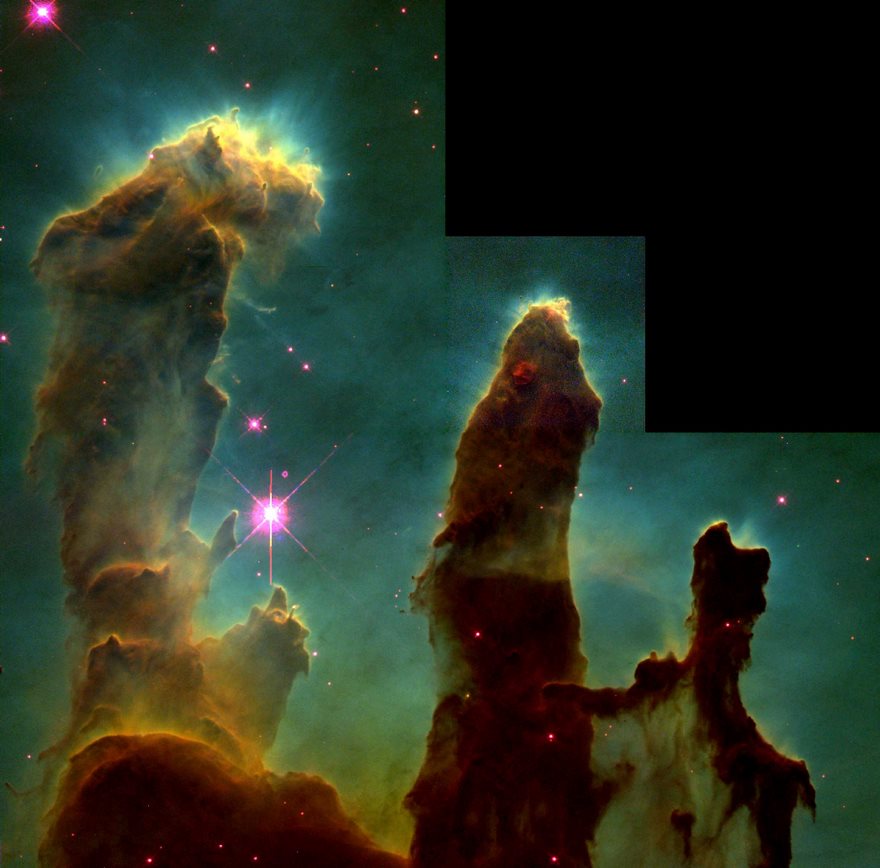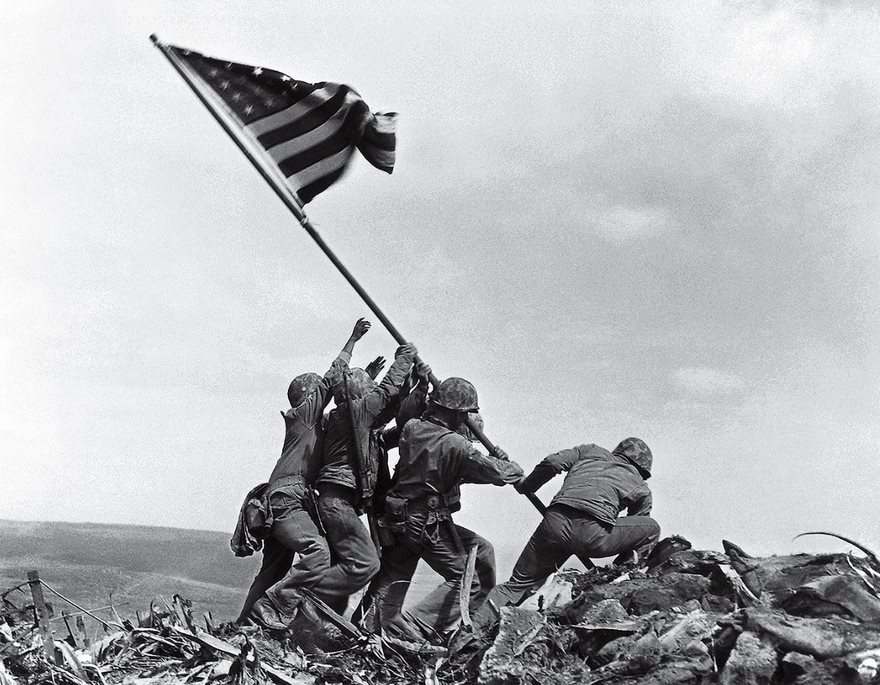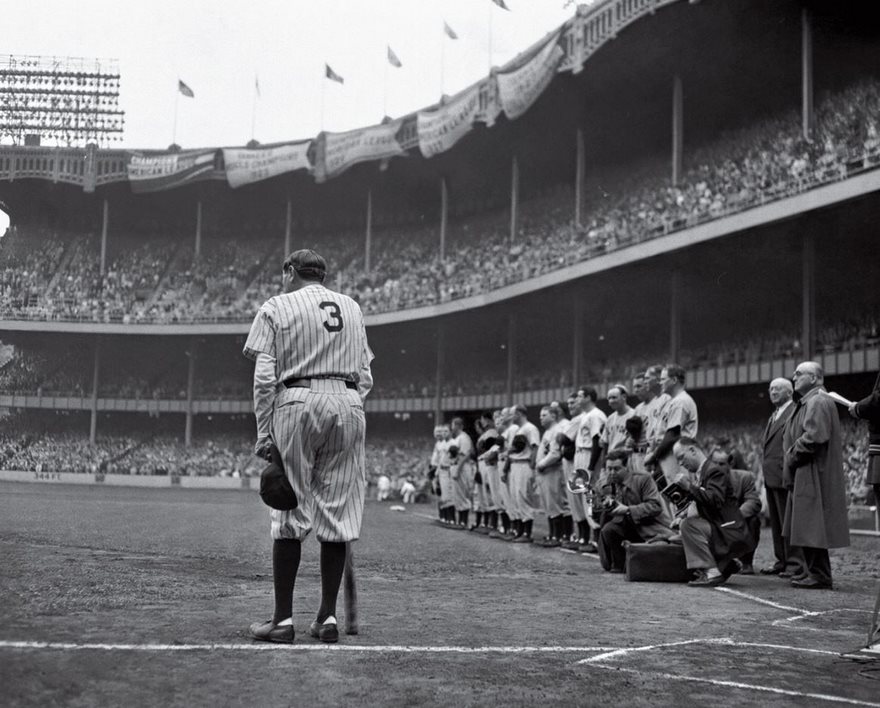3 Famous Photos

Pillars of Creation, NASA, 1995
The Hubble Space Telescope almost didn’t make it. Carried aloft in 1990 aboard the space shuttle Atlantis, it was over-budget, years behind schedule and, when it finally reached orbit, nearsighted, its 8-foot mirror distorted as a result of a manufacturing flaw. It would not be until 1993 that a repair mission would bring Hubble online. Finally, on April 1, 1995, the telescope delivered the goods, capturing an image of the universe so clear and deep that it has come to be known as Pillars of Creation. What Hubble photographed is the Eagle Nebula, a star-forming patch of space 6,500 light-years from Earth in the constellation Serpens Cauda. The great smokestacks are vast clouds of interstellar dust, shaped by the high-energy winds blowing out from nearby stars (the black portion in the top right is from the magnification of one of Hubble’s four cameras). But the science of the pillars has been the lesser part of their significance. Both the oddness and the enormousness of the formation—the pillars are 5 light-years, or 30 trillion miles, long—awed, thrilled and humbled in equal measure. One image achieved what a thousand astronomy symposia never could.
I selected this one because I’ve known of this one before and I just think it looks so optimistic and wonderous and how it actually looks like a hand which formed the universes creation.

Flag Raising On Iwo Jima, Joe Rosenthal, 1945
It is but a speck of an island 760 miles south of Tokyo, a volcanic pile that blocked the Allies’ march toward Japan. The Americans needed Iwo Jima as an air base, but the Japanese had dug in. U.S. troops landed on February 19, 1945, beginning a month of fighting that claimed the lives of 6,800 Americans and 21,000 Japanese. On the fifth day of battle, the Marines captured Mount Suribachi. An American flag was quickly raised, but a commander called for a bigger one, in part to inspire his men and demoralize his opponents. Associated Press photographer Joe Rosenthal lugged his bulky Speed Graphic camera to the top, and as five Marines and a Navy corpsman prepared to hoist the Stars and Stripes, Rosenthal stepped back to get a better frame—and almost missed the shot. “The sky was overcast,” he later wrote of what has become one of the most recognizable images of war. “The wind just whipped the flag out over the heads of the group, and at their feet the disrupted terrain and the broken stalks of the shrubbery exemplified the turbulence of war.” Two days later Rosenthal’s photo was splashed on front pages across the U.S., where it was quickly embraced as a symbol of unity in the long-fought war. The picture, which earned Rosenthal a Pulitzer Prize, so resonated that it was made into a postage stamp and cast as a 100-ton bronze memorial.
I chose this photo because I think it signifies what America is and how strong we are together. It also states a major part in history as this is the point in time where we have almost won WWII.

The Babe Bows Out, Nat Fein, 1948
He was the greatest ballplayer of them all, the towering Sultan of Swat. But by 1948, Babe Ruth had been out of the game for more than a decade and was struggling with terminal cancer. So when the beloved Bambino stood before a massive crowd on June 13 to help celebrate the silver anniversary of Yankee Stadium—known to all in attendance as the House That Ruth Built—and to retire his No. 3, it was clear this was a final public goodbye.
Nat Fein of the New York Herald Tribune was one of dozens of photographers staked out along the first-base line. But as the sound of “Auld Lang Syne” filled the stadium, Fein “got a feeling” and walked behind Ruth, where he saw the proud ballplayer leaning on a bat, his thin legs hinting at the toll the disease had wreaked on his body. From that spot, Fein captured the almost mythic role that athletes play in our lives—even at their weakest, they loom large. Two months later Ruth was dead, and Fein went on to win a Pulitzer Prize for his picture. It was the first one awarded to a sports photographer, giving critical legitimacy to a form other than hard-news reportage.
I found this photo interesting because Babe Ruth was one of the greatest players in his time and in his final game he gets an ovation unlike any other as one of the greats say goodbye.
Travel Poster

I want like to travel to this place because it is such a beautiful city filled with lights. I would also want to go because of the attractions, the attractions are limitless from shows to street entertainers.
White Balance
White balance is crucial aspect of photography that ensures the colors in an image are accurate and natural-looking. It refers to the process of adjusting the colors in an image so that white appears neutral and free from any unwanted color casts. A camera’s white balance setting adjusts the color temperature of the image, depending on the lighting conditions in which the photo is being taken. If the white balance is not properly set, the resulting image may appear too warm or too cold. Understanding and setting the white balance is essential to capture the colors in the scene as accurately as possible. Professional photographers often use a gray card to find the proper white balance in their photos. The correct white balance can make a significant difference in the overall look and feel of a paragraph.
Lightroom and Photoshop
Differences
- Lightroom is faster and easier to use than Photoshop
- Lightroom can handle basic photo editing tasks such as cropping or rotating
- Lightroom is a nondestructive photo workflow, adjustment and management program, while Photoshop is a pixel-level, layer-based image manipulation program
Similarities
- Use of Adobe Camera RAW
- Built-in editing tools
- File processing
Portraits

Aperture priority, 1/100sec, f/3.5, ISO 320, 22.00mm

Aperture Priority, 1/100 sec, f/4.0, ISO 400, 29.00mm

Aperture Priority, 1/8 sec, f/18, ISO 200, 65.00mm

Aperture Priority, 1/15 sec, f/18, ISO 200, 85.00mm

Shutter priority, 1/160 sec, f/4.5, ISO 200, 60.00mm

Shutter Priority, 1/160 sec, f/4.5, ISO 200, 50.00mm
10 Tips On Shooting Portraits
- Alter Your Perspective
- Play With Eye Contact
- Looking Within the Frame
- Experiment With Lighting
- Move Your Subject Out of Their Comfort Zone
- Shoot Candidly
- Introduce A Prop
- Focus on One Body Part
- Obscure Part of Your Subject
- Take A Series of Shots to Capture the Action
Action & Motion Response

1/1000sec, f/5.6, 55.00mm
1/10sec, f/4.0, 18.00mm
Action & Motion

1/1000 sec, f/5.6, ISO 200, Shutter priority, 125.00mm

1/500sec, f/8, ISO 200, Shutter priority, 135.00mm

24.00mm, 1/30sec, f/4.0, ISO 160, Sutter priority

18.00mm, 1/30sec, f/3.5, ISO 160, Shutter priority
Action and Motion Explained
Action and motion photography is the art of capturing motion and movement in a photograph. It is the ability to use the camera to freeze a moment in time, portraying the subject in a way that highlights the energy, speed, or power involved in the action. This type of photography is all about capturing the essence of motion in a way that translates into an image. It is widely used in sports photography, wildlife photography, and street photography, among many others.
Action photography requires careful, consideration of the camera setting, subject positioning, and timing. A fast shutter speed is a must, as it helps to freeze the motion an avoid blurriness. Additionally, the photographer must consider the distance between themselves and the subject to establish the right perspective and focal length for the shot. Capturing sudden or unexpected movements is all about quick reflexes and knowledge of the subject’s behavior. Taking a perfect action shot requires experience, skill, and practice.
Motion photography is all about capturing movement and depicting it in a single frame. It is a reflection of the velocity, momentum, or fluidity of an object or subject. Unlike action photography, motion photography often involves longer shutter speeds, which help to blur the movement and create a sense of speed, direction, or pattern. This type of photography is usually seen in landscape photography, street photography, or objects in motion, such as cars or boats. The skills required for motion and action photography are similar, with a need for quick reflexes, technical expertise, and creativity to capture the beauty of motion.













